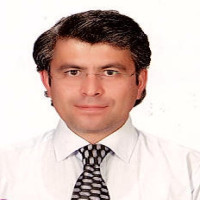Original Article
Case Report
Issue Editorial Board









 0000-0002-7018-7187
0000-0002-7018-7187
Aim & Scope
The aim of our journal is to publish prospective, retrospective and experimental researches, case reports and review for every area of medicine.
Medical Journal of Mugla Sitki Kocman University is a periodical of Medical School of Mugla Sitki Kocman University and is published three times per year; in April, August, and December. The Medical Journal of Mugla Sitki Kocman University’s publication languages are both Turkish and English.
The articles which could be prospective or retrospective on investigational studies, case reports and reviews of every aspect of medicine are published. The studies should have paramount ethical and scientific standards as well as no commercial concerns. Articles are accepted for publication on the condition that they are original, are not under consideration by another journal, or have not been previously published.
The Medical Journal of Mugla Sitki Kocman University is indexed by TR Dizin, Google Scholar, Türkiye Atıf Dizini, Academic Keys and Research Bible.
All manuscripts must be submitted electronically on the https://dergipark.org.tr/muskutd. Instructions for authors, technical information, and other necessary forms can be accessed over this web page. Authors are responsible for all content of the manuscripts.
Rights to the use and reproduction, including in the electronic media, of all communications, papers, photographs and illustrations appearing in this journal belong to the Medical Journal of Mugla Sitki Kocman University without prior written permission of part or all of and material is forbidden. All rights are reserved. Published content of the journal is in authors’ own responsibility. Mugla Sitki Kocman University School of Medicine, editors, employees and the publisher do not accept any financial, legal or any other liability for the published material.
Author Guidelines
INSTRUCTIONS FOR AUTHORS
https://dergipark.org.tr/muskutd/page/4152
General Information
Medical Journal of Mugla Sitki Kocman University is a periodical of Medical School of Mugla Sitki Kocman University. The journal is published quadmonthly. The articles which could be prospective or retrospective on investigational studies, case reports and reviews of every aspect of medicine are published. The studies should have paramount ethical and scientific standards as well as no commercial concerns Articles are accepted for publication on the condition that they are original, are not under consideration by another journal, or have not been previously published. The studies that are sent to the journal provided that the study is appropriate for formal principles are evaluated by the editor and two peer reviewers. The study is published once the approvals of the reviewers have been taken. Hence, the authors should make the necessary changes in accordance with the reviewers’ comments.
Scientific Responsibility
All authors should have contributed to the article directly either academically or scientifically. All persons designated as authors should plan or perform the study, write the paper or review the versions, approve the final version. It is the authors’ responsibility to prepare a manuscript that meets scientific criteria.
Ethical Responsibility
The Medical Journal of Muğla Sıtkı Koçman University aims to contribute to the advancement of science by publishing articles that comply with ethical and scientific standards. It is important to adhere to ethical norms in scientific research. Ethical principles, based on the directive prepared by COPE (Committee on Publication Ethics) (https://publicationethics.org/resources/resources-and-further-reading/international-standards-editors-and-authors), have been adopted by the Medical Journal of Muğla Sıtkı Koçman University and it is recommended to be adopted by authors, reviewers and editors. Some of these suggestions are given below.
Ethical Responsibilities of Authors:
- Authors should be able to keep the data records related to the research and give access to this data upon a possible request.
- Make sure that the article is not published or accepted elsewhere.
- To ensure compliance with national and international laws and guidelines for all reseach involving human or animal subjects (for example, the WMA Helsinki Declaration, the NIH Laboratory Animal Policy, the EU Directive on Animal Use), to confirm that the necessary approvals have been obtained, to respect the subject's privacy. To specify the relevant ethics committee approvals and research details regarding the research in the “Materials and Methods” section of the study.
- In the event of any conflict of interest, whenever the author detects an ethical violation related to article, should share it with the editor and publisher, publish a bug addendum, compensation notice, or withdraw the work when deemed necessary.
Ethical Responsibilities of Reviewers:
- To contribute to the decision-making process of the editor, they should review the article objectively in time and only accept the evaluation of the research related to his/her area of expertise.
- Evaluate objectively only on the content of the study.
- They should consider working without regard to religious, political and economic interests.
- They should provide guidance to help improve the quality of the article to be published and scrutinize the study. Reviewer should convey the comments constructively and kindly to the author.
-They should protect the confidentiality of the information provided by the editor and the author.
- Be aware of potential conflicts of interest (financial, institutional, collaborative, or other relationship between the author and the author) and, if necessary, alert the editor to withdraw their help for this article.
Ethical Duties and Responsibilities of Editors:
- They should act in a balanced, objective and fair manner while performing their duties, without discrimination on gender, religious or political beliefs, and ethnic or geographical origin of the authors.
- They should evaluate the studies submitted according to their content and should not show any privilege to any author.
- Take the necessary precautions to prevent possible conflicts of interest and evaluate existing statements.
- In case of an ethical complaint, they should follow the journal's policies and procedures and follow the necessary procedures. They should give the authors an opportunity to respond to the complaint, and should not avoid applying the necessary sanctions regardless of whoever the study belongs to.
- If the submitted study is not in line with the purpose and scope of the journal, it must be rejected.
In all research articles (including retrospective studies), Ethics Committee Approval must be obtained for the study and the location, date (day, month and year) and approval number of the Ethics Committee Approval must be specified in the Materials and Methods section. It should be noted that the study was carried out according to the Helsinki Declaration (World Medical Association Declaration of Helsinki http://www.wma.net/en/30/publications/10policies/b3/index.html) in all studies involving human participants. In case reports, the sentence ‘’written informed consent was obtained from the patient (or from the legal guardian), which indicates that medical data can be published’’ must be stated together with the informed consent date. For experimants on animals, institutional or national guidelines on the care and use of laboratory animals should be followed and reported. The editor and editorial board are not responsible for the sentences used by the authors in their study. Scientific, legal and ethical responsibility belongs to the authors.
The corresponding author should state that the submitted manuscript is not published elsewhere and is not in the process of being evaluated in another journal at the same time. If part of the study was presented as an oral or poster presentation in the congress, the title page should be specified by giving the name of the congress, place and date. Accepted manuscripts become the permanent property of the journal and may not be published elsewhere without permission.
Evaluation: All articles are evaluated by at least two reviewers using double-blind evaluation. The evaluation of the articles is done by considering their scientific importance and originality. Manuscripts accepted for publication can be edited by the editorial board by informing the authors without changing the content.
Check for Plagiarism: Articles submitted are checked for format and plagiarism. Articles that are not suitable for format or have high plagiarism similarity rate (should be less than 20%) are sent back to the responsible author for evaluation.
Conflict of interest: If there is an institution directly or indirectly providing financial support for any personal, commercial connection or study that may be a party to their work, the authors; must notify the editor on the presentation page of the commercial product, drug, or commercial relationship with the company. If there is no conflict of interest, the authors should state that 'Authors declare that there is no conflict of interest'.
Language
The official languages of the Journal are Turkish and English. Turkish dictionary published by Turkish Language Institution (www.tdk.gov.tr) should be predicated on Turkish manuscripts. All spelling and grammar mistakes in the submitted articles are corrected by the editor without changing the data presented. It is the authors’ responsibility to prepare a manuscript that meets spelling and grammar rules.
Copyright Statement
A copyright transfer statement indicating that the ‘The copyright to this article is transferred to Medical Journal of Mugla Sitki Kocman University and will be effective if and when the article is accepted for publication’ should be sent in the content of cover letter. No payment is done to authors for their articles.
Article Types
Reviews: The reviews highlight or update new and/or controversial areas. Reviews should include Turkish and English titles and abstracts. Abstract should be as one paragraph, include keywords. The editor of the Journal invites author/authors for reviews.
Original articles: Original articles describe the results of basic or clinical studies or clinical trials. Original articles should follow the basic structure of an abstract, introduction, materials and methods, results, discussion, references, and tables and figures (as appropriate).
Case Reports: The Journal publishes significant case reports related to the every aspect of medicine. Case reports should follow the basic structure of an abstract, introduction, case report, discussion, references, and tables and figures (as appropriate).
Manuscript Submission
All manuscripts must be submitted electronically on the https://dergipark.org.tr/muskutd
Preparation of Manuscripts
Submissions should be doubled-spaced and typed in Times New Roman 12 points with line numbers. All pages should be numbered consecutively in the bottom right-hand corner, beginning with the title page. The title page should not include the names and institutions of the authors. Manuscript must be prepared as a word file (*.doc, *.docx).
Cover letter: Cover letter should include statements about manuscript category designation, single-journal submission affirmation, conflict of interest statement, copyright transfer statement, sources of outside funding, equipments (if so).
Title Page: On the title page, provide the complete title and a running title. List each contributor's name, institutional affiliation and ORCID number. The individual ORCID number can be obtained from http://orcid.org. Corresponding Author is the contributor responsible for the manuscript and proofs. This is the person to whom all correspondence and reprints will be sent. The corresponding author is responsible for keeping the Editorial Office updated with any change in details until the paper is published. If part of the study was presented as an oral or poster presentation in the congress, the title page should be specified by giving the name of the congress, place and date.
Abstract and Keywords: The abstract must not exceed 250 words. It should summarize the aim of the study and describe the work undertaken, results and conclusions. In addition, you should list up to five keywords. The words should be separated by comma (,), from each other. English key words should be appropriate to “Medical Subject Headings (MESH)” www.nlm.nih.gov/mesh/MBrowser.html Turkish key words should be appropriate to “Türkiye Bilim Terimleri (TBT)” www.bilimterimleri.com
Introduction: The Introduction should briefly discuss the objectives of the study and provide the background information to explain why the study was undertaken, and what hypotheses were tested.
Materials and Methods: Clearly explain the methods and the materials in detail to allow the reader to reproduce the results. Equipment and apparatus should cite the make and model number and the company name and address (town, county, and country) at first mention. Give all measurements in metric units. Use generic names of drugs.
Statistically Evaluation: All retrospective, prospective and experimental research articles must be evaluated in terms of biostatics and it must be stated together with appropriate plan, analysis and report. p values must be given in the manuscripts.
Results: Results must be presented in a logic sequence with text, tables and illustrations. Tables and text should not duplicate each other. p values must be given in the manuscripts (as p=0.014).
Discussion: This section should be concise. Emphasize only the new and most important aspects of the study and their conclusions. The Discussion should include a brief statement of the principal findings, a discussion of the validity of the observations, a discussion of the findings in light of other published work dealing with the same or closely related subjects, and a statement of the possible significance of the work. Authors are encouraged to conclude with a brief paragraph that highlights the main findings of the study.
Acknowledgements: Authors must acknowledge individuals who do not qualify as Authors but who contributed to the research. Abbreviations: The abbreviation of a word or word sequence is given in the first appearance within a bracket after the word or word sequence. The abbreviation is used through the main text
Tables, Figures and Graphs: All tables, figures, graphs and other visual media must be numbered in order of citation within the text and must not disclose the names of the patients, doctors or institutions. Tables must be placed at the end of the references section in the main document. Tables should not be submitted in JPEG, TIFF or other visual formats. In microscopic images, magnification and staining techniques must be specified in addition to figure captions. All images should be in high resolution with minimum 300 DPI. All illustrations (including line drawings and photographs) are classified as figures. Figures must be added to the system as separate .jpg or .gif files. Figures should be numbered consecutively in Arabic numbers and should be cited in parenthesis in consecutive order in the text. Lines in the graphs must be in adequate thickness. Therefore, loss of details would be minimal if reduction is needed during press. Abbreviations used in tables must be defined in alphabetical order at the bottom of the tables. Roman numerals should be avoided while numbering the Tables and Figures, or while citing the tables in the text.
References: References in the text must be numbered in the order of citation and must be given with natural numbers within a bracket at the end of the sentence. List all Authors when three or fewer; when four or more, list only the first three and add ‘et al’. Journal titles should be cited in full. The style of references and abbreviated titles of journals must follow that of Index Medicus or one of the examples illustrated below:
Format for Journal Articles:
Murtaugh TJ, Wright LS, Siegel FL. Calmodulin plus cyclic AMP-dependent phosphorylation of a Mr 22,000 pituitary protein. J Biol Chem. 1985;260(29):15932-7.
Format for Committees and Groups of Authors:
The Standard Task Force, American Society of Colon and Rectal Surgeons: Practice parameters for the treatment of haemorrhoids. Dis Colon Rectum 1993;36:1118-20.
Format for Chapter from a Book:
Milson JW. Haemorrhoidal disease. In: Beck DE, Wexner S, eds. Fundamentals of Anorectal Surgery. 1 1992; 192-214. 1a ed. New York: McGraw-Hill
Format for Books and Monographs:
Bateson M, Bouchier I. Clinical Investigation and Function, 2nd edn. Oxford: Blackwell Scientific Publications Ltd, 1981.
Ethical Principles and Publication Policy
Ethical Responsibility
The Medical Journal of Muğla Sıtkı Koçman University aims to contribute to the advancement of science by publishing articles that comply with ethical and scientific standards. It is important to adhere to ethical norms in scientific research. Ethical principles, based on the directive prepared by COPE (Committee on Publication Ethics) (https://publicationethics.org/resources/resources-and-further-reading/international-standards-editors-and-authors), have been adopted by the Medical Journal of Muğla Sıtkı Koçman University and it is recommended to be adopted by authors, reviewers and editors. Some of these suggestions are given below.
Ethical Responsibilities of Authors:
- Authors should be able to keep the data records related to the research and give access to this data upon a possible request.
- Make sure that the article is not published or accepted elsewhere.
- To ensure compliance with national and international laws and guidelines for all reseach involving human or animal subjects (for example, the WMA Helsinki Declaration, the NIH Laboratory Animal Policy, the EU Directive on Animal Use), to confirm that the necessary approvals have been obtained, to respect the subject's privacy. To specify the relevant ethics committee approvals and research details regarding the research in the “Materials and Methods” section of the study.
- In the event of any conflict of interest, whenever the author detects an ethical violation related to article, should share it with the editor and publisher, publish a bug addendum, compensation notice, or withdraw the work when deemed necessary.
Ethical Responsibilities of Reviewers:
- To contribute to the decision-making process of the editor, they should review the article objectively in time and only accept the evaluation of the research related to his/her area of expertise.
- Evaluate objectively only on the content of the study.
- They should consider working without regard to religious, political and economic interests.
- They should provide guidance to help improve the quality of the article to be published and scrutinize the study. Reviewer should convey the comments constructively and kindly to the author.
-They should protect the confidentiality of the information provided by the editor and the author.
- Be aware of potential conflicts of interest (financial, institutional, collaborative, or other relationship between the author and the author) and, if necessary, alert the editor to withdraw their help for this article.
Ethical Duties and Responsibilities of Editors:
- They should act in a balanced, objective and fair manner while performing their duties, without discrimination on gender, religious or political beliefs, and ethnic or geographical origin of the authors.
- They should evaluate the studies submitted according to their content and should not show any privilege to any author.
- Take the necessary precautions to prevent possible conflicts of interest and evaluate existing statements.
- In case of an ethical complaint, they should follow the journal's policies and procedures and follow the necessary procedures. They should give the authors an opportunity to respond to the complaint, and should not avoid applying the necessary sanctions regardless of whoever the study belongs to.
- If the submitted study is not in line with the purpose and scope of the journal, it must be rejected.
In all research articles (including retrospective studies), Ethics Committee Approval must be obtained for the study and the location, date (day, month and year) and approval number of the Ethics Committee Approval must be specified in the Materials and Methods section. It should be noted that the study was carried out according to the Helsinki Declaration (World Medical Association Declaration of Helsinki http://www.wma.net/en/30/publications/10policies/b3/index.html) in all studies involving human participants. In case reports, the sentence ‘’written informed consent was obtained from the patient (or from the legal guardian), which indicates that medical data can be published’’ must be stated together with the informed consent date. For experimants on animals, institutional or national guidelines on the care and use of laboratory animals should be followed and reported. The editor and editorial board are not responsible for the sentences used by the authors in their study. Scientific, legal and ethical responsibility belongs to the authors.
The corresponding author should state that the submitted manuscript is not published elsewhere and is not in the process of being evaluated in another journal at the same time. If part of the study was presented as an oral or poster presentation in the congress, the title page should be specified by giving the name of the congress, place and date. Accepted manuscripts become the permanent property of the journal and may not be published elsewhere without permission.
Evaluation: All articles are evaluated by at least two reviewers using double-blind evaluation. The evaluation of the articles is done by considering their scientific importance and originality. Manuscripts accepted for publication can be edited by the editorial board by informing the authors without changing the content.
Check for Plagiarism: Articles submitted are checked for format and plagiarism. Articles that are not suitable for format or have high plagiarism similarity rate (should be less than 20%) are sent back to the responsible author for evaluation.
Conflict of interest: If there is an institution directly or indirectly providing financial support for any personal, commercial connection or study that may be a party to their work, the authors; must notify the editor on the presentation page of the commercial product, drug, or commercial relationship with the company. If there is no conflict of interest, the authors should state that 'Authors declare that there is no conflict of interest'.
Price Policy
Ücretsiz

